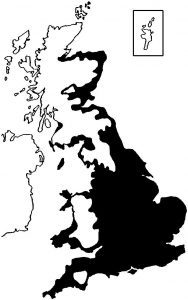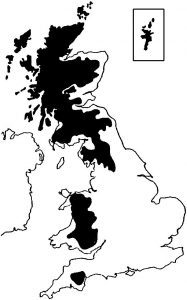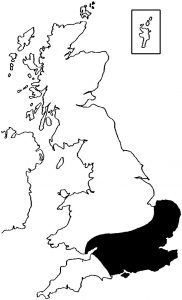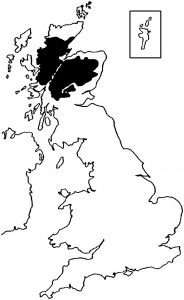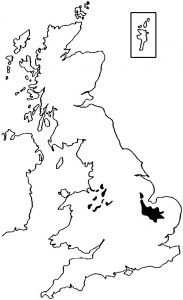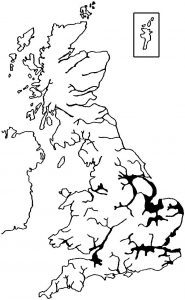Printed from: https://finalhbks.asgoodasready.com/woodlands/national-vegetation-classification/
New native woodland types
The following tables detail the major and minor tree and shrub species suitable for creating new native woodlands, based on National Vegetation Classification (NVC) woodland types. The distribution and soils of the NVC types are shown below.
NATIVE TREES
Major and minor species for new native woodland types
● = major species throughout range
■ = major species locally or in part of range
❑ = minor species throughout range
❍ = minor species locally or in part of range
KEY TO WOODLAND TYPES
W2 Alder woodland with common reed
W4 Birch woodland with purple moor-grass
W6 Alder woodland with stinging nettle
W7 Alder-ash woodland with yellow pimpernel
W8 Lowland mixed broadleaved woodland with dog’s mercury
W9 Upland mixed broadleaved woodland with dog’s mercury
W10 Lowland mixed broadleaved woodland with bluebell
W11 Upland oak-birch woodland with bluebell
W12 Beech-ash woodland with dog’s mercury
W14 Beech-oak woodland with bramble
W15 Beech-oak woodland with wavy hair-grass
W16 Lowland oak-birch woodland with bilberry
W17 Upland oak-birch woodland with bilberry
W18 Scots pine woodland with heather
W19 Juniper woodland with wood sorrel
Native Trees: Major and minor species for new native woodland types
| W8 | W9 | W10 | W11 | W16 | W17 | W12 | W14 | W15 | W18 | W19 | W2 | W6 | W7 | W4 | |
|---|---|---|---|---|---|---|---|---|---|---|---|---|---|---|---|
| Alder | ❑ | ● | ● | ● | ❑ | ||||||||||
| Ash | ● | ● | ❍ | ● | ❑ | ❑ | ❑ | ● | |||||||
| Aspen | ❍ | ❍ | ❍ | ❍ | ❍ | ||||||||||
| Beech | ● | ● | ● | ||||||||||||
| Birch, downy | ❑ | ● | ❍ | ● | ■ | ● | ❍ | ❑ | ● | ❑ | ❑ | ● | |||
| Birch, silver | ❑ | ● | ❍ | ● | ❍ | ❑ | ❑ | ❑ | ❍ | ||||||
| Crab apple | ❑ | ❑ | |||||||||||||
| Elm, wych | ■ | ❑ | ■ | ||||||||||||
| Field maple | ■ | ❑ | |||||||||||||
| Cherry, gean | ❍ | ❍ | ❑ | ||||||||||||
| Cherry, bird | ❑ | ❍ | |||||||||||||
| Holly | ❑ | ❑ | ❑ | ❑ | ❑ | ❑ | ❑ | ● | ● | ❑ | ❑ | ||||
| Hornbeam | ❍ | ❍ | ❑ | ||||||||||||
| Oak, common | ● | ❍ | ● | ❍ | ● | ❍ | ❑ | ● | ● | ❑ | ❑ | ❑ | |||
| Oak, sessile | ■ | ❑ | ■ | ● | ■ | ● | ❍ | ❍ | ❑ | ||||||
| Rowan | ❍ | ● | ❑ | ❑ | ❑ | ❑ | ❑ | ❑ | ❑ | ❑ | ❑ | ||||
| Scots pine | ● | ||||||||||||||
| Whitebeam | ❍ | ❍ | ❑ | ||||||||||||
| Willow, crack | ❑ | ● | |||||||||||||
| Willow, goat | ❑ | ❑ | ❑ | ❑ | ❑ | ||||||||||
| Yew | ❑ | ❑ | ❑ |
Native Shrubs: Major and minor species for new native woodland types
| W8 | W9 | W10 | W11 | W16 | W17 | W12 | W14 | W15 | W18 | W19 | W2 | W6 | W7 | W4 | |
|---|---|---|---|---|---|---|---|---|---|---|---|---|---|---|---|
| Blackthorn | ❑ | ❑ | ❑ | ❑ | |||||||||||
| Broom | ❑ | ||||||||||||||
| Buckthorn, alder | ❍ | ❑ | ❑ | ❍ | |||||||||||
| Buckthorn, purging | ❍ | ❑ | ❍ | ||||||||||||
| Dogwood | ❍ | ❑ | |||||||||||||
| Elder | ❑ | ❑ | ❑ | ❍ | ❑ | ❑ | ● | ❑ | |||||||
| Gorse | ❑ | ❑ | |||||||||||||
| Guelder rose | ❑ | ❑ | ❑ | ❑ | ❑ | ❑ | |||||||||
| Hawthorn | ● | ❑ | ● | ❑ | ❍ | ● | ❑ | ❑ | ❑ | ● | |||||
| Hazel | ● | ● | ● | ❑ | ❍ | ● | ❑ | ● | |||||||
| Wild privet | ❑ | ❑ | ❑ | ||||||||||||
| Spindle | ❍ | ❑ | |||||||||||||
| Wayfairing tree | ❍ | ❍ | ❑ | ||||||||||||
| Juniper | ❍ | ❍ | ❑ | ❑ | ● | ||||||||||
| Willow, almond | ❑ | ||||||||||||||
| Willow, bay | ❍ | ❑ | |||||||||||||
| Willow, eared | ❑ | ❑ | |||||||||||||
| Sallow, grey | ❑ | ❑ | ● | ● | ● | ● | |||||||||
| Willow, osier | ❑ | ||||||||||||||
| Willow, purple | ❑ |
Distribution of NVC woodland types
Map 1: The lowland zone of Britain
| NVC number | W8 | W10 | W16 |
|---|---|---|---|
| NVC name | Lowland mixed broadleaved woodland with dog's mercury | Lowland mixed broadleaved woodland with bluebell | Lowland oak-birch woodland with bilberry |
| Soil type | Rendzinas and calcareous brown earths | Base-rich brown earths | Podzolic and ironpan soils |
Map 2: The upland zone of Britain
| NVC number | W9 | W11 | W17 | W4 | W7 |
|---|---|---|---|---|---|
| NVC name | Upland mixed broadleaved woodland with dog's mercury | Upland oak-birch woodland with bluebell | Upland oak-birch woodland with bilberry | Birch woodland with purple moor-grass | Alder-ash woodland with yellow pimpernel |
| Soil type | Rendzinas and calcareous brown earths | Base-poor brown earths | Podzolic and ironpan soils | Wet peat | Wet gleys and brown earths |
Map 3: The zone of semi-natural beech woodlands
| NVC number | W12 | W14 | W15 |
|---|---|---|---|
| NVC name | Beach-ash woodland with dog's mercury | Beech-oak woodland with bramble | Beech-oak woodland with wavy hair-grass |
| Soil type | Rendzinas | Base-poor brown earths | Podzols |
Map 4: The zone of semi-natural pine woodland
| NVC number | W18 |
|---|---|
| NVC name | Scots pine woodland with heather |
| Soil type | Highly acidic podzols |
Map 5: The zone of upland juniper woodland
| NVC number | W19 |
|---|---|
| NVC name | Juniper woodland with wild sorrel |
| Soil type | Neutral brown earths |
Map 6: Wet woodland on fen peat
| NVC number | W2 |
|---|---|
| NVC name | Alder woodland with common reed |
Map 7: Wet woodland on alluvium
| NVC number | W6 |
|---|---|
| NVC name | Alder woodland with stinging nettle |

